| One of the
great joys about Sunday
mornings in London when I
was a child was in going
to the street markets
that took place then.
There were a number at
that time with markets in
Brick Lane, Wentworth
Street, Middlesex Street,
Club Row and, best of
all, the Columbia Road
Flower Market. Of
all of London’s
markets, Petticoat
Lane together with
the Portobello Road
Market, are the most
famous. Most visitors to
London are sure to visit Petticoat
Lane during their
time in the city.
Although it is a must-see-site
for many, it is
surprisingly not
officially designated as
a tourist attraction
– go figure!
Petticoat Lane is a
weekday market that is
found on Wentworth
Street and when I was
a child, I found it to be
a magical and wondrous
street filled with the
most succulent things to
eat. On Sundays, the
market expands over to Middlesex
Street.
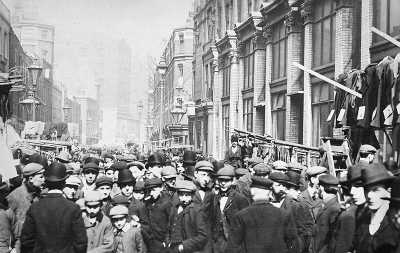 |
|
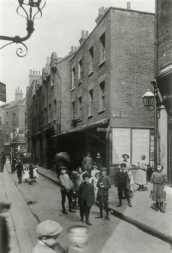 |
| Petticoat
Lane in the past |
The
interesting thing about
Sunday markets is that
they were, and still are
required to close, by
law, by 2 p.m. Certain
markets in the East End
were originally allowed
to open on Sundays to
accommodate Jewish
settlers who did not work
or shop on Saturdays.
This proved useful to
non-Jewish sellers as
well, as it allowed them
to sell anything not sold
in the markets on the
previous day.
'Look
at Life' - The Market
The market
roadway was once called Hogs
Lane and had been a
place where the wealthy
kept pigs. By 1590, this
road, which was now known
as Peticote Lane
became well known as a
site for the selling and
exchange of goods. A
formal market has existed
here, just outside of the
old London city wall,
since the beginning of
the 17th
Century when second-hand
clothes and junk began
to be offered to the
public. Towards the end
of the century, the Huguenots
left France and came
to Spitalfields
and helped increase the
manufacturing and sales
of clothing in the area.
In the 1850s, Peticote
Lane was renamed to Middlesex
Street and marked the
border between the City
of London and Whitechapel.
From 1882, Jewish
immigrants fleeing from
Eastern Europe came to
the area and entered the
shmateh trade of
the area.
Following the devastation
of the East End during
the Second World War, the
market declined to some
extent, but has revived
thanks to the Asian
immigrants that now live
in the area.
Until the
1930s, the market was not
officially recognized by
the City Fathers
and was a source of irritation
to them, who often called
upon the police to
disrupt it. However in
1936, its rights as a
market, at long last,
became protected by an Act
of Parliament. And
despite City Fathers, a
world war, various
out-fluxes of the
populace, along with
changing tastes and
fashions, the market
continues to flourish.
 When
I was a child, my parents
would take me to Petticoat
Lane about once a
month. It was here that I
first met Prince
Monolulu who advised
me to become a jockey and
gave me my first
contribution towards the
purchase of a horse.
During my early years I
went to the market many
times, both during the
week and on Sundays. I
have to confess that when
I was sent to Sunday
school, I would
occasionally not go and
would take off for fun
and a ramble down the
lane. When
I was a child, my parents
would take me to Petticoat
Lane about once a
month. It was here that I
first met Prince
Monolulu who advised
me to become a jockey and
gave me my first
contribution towards the
purchase of a horse.
During my early years I
went to the market many
times, both during the
week and on Sundays. I
have to confess that when
I was sent to Sunday
school, I would
occasionally not go and
would take off for fun
and a ramble down the
lane.
In those
days, the costermongers,
as the people that worked
on the stalls were
called, were colourful
characters in themselves
and it was great
entertainment just to
stand and watch them in
action. It was normal for
the costermongers to
provide a performance and
entertain the public for
a while in hope of
attracting a large group
of potential punters around
them. Once this was done,
they would then launch
into their spiel or
sales pitch. I
used to love to stand and
watch some of them in
action. It was amazing
how they were able to
manipulate the crowd into
buying anything and
everything.
 These
sellers were amazing and
talented men and were
able to sell anything
– clothes,
kitchen utensils,
envelopes, food, bedding
etc – you name
it, they could sell it!
I seem to remember that
things like bath towels,
sheets and pillow cases
were very popular and
there were many stalls
selling them. Another
particular item that was
very popular was
crockery. This would
include anything and
everything that could be
drunk from or eaten off. These
sellers were amazing and
talented men and were
able to sell anything
– clothes,
kitchen utensils,
envelopes, food, bedding
etc – you name
it, they could sell it!
I seem to remember that
things like bath towels,
sheets and pillow cases
were very popular and
there were many stalls
selling them. Another
particular item that was
very popular was
crockery. This would
include anything and
everything that could be
drunk from or eaten off.
One of my
favourite entertainers
was a local man who I
believed was called Jack.
Jack was a cockney,
with a deep powerful
booming voice with lots
of the old pitter
patter (i.e. chat
– an ability to
talk; with a talent to
a phrase). He always
dressed in a unique and dapper
style which included
a dark brown trilby hat
and a gold coloured silk
waistcoat with a gold
watch and chain dangling
from its pockets over a
white shirt and dark
brown tie. When it was
time for him to perform,
he would step up onto
a platform of empty
wooden fruit crates piled
up behind his stall. From
here, he was able to
survey the scene, like a
king holding court.
Jack’s
stall was typical of many
down the lane, as
it was stacked with
crockery – cups,
saucers, tea services,
dinner services etc.
Although most of his ware
was undoubtedly ordinary
stuff, he had the
necessary gift of the gab
to convince many that
he was flogging
quality stuff. This
man had great charm and
was able to convince the punters
that either he was giving
it away for next
to nothing or that
they were stealing it
from him at rock
bottom prices. I am
sure that most of his clobber
was seconds that
costermongers knew
how to get hold of
cheaply and I expect that
no matter how little he
charged for his goods, he
wasn’t losing by
it.
Jack was
always aided by one or
two helpers or runners
who were there to move
amongst the crowd to
collect the dibbles
in return for the sales.
These fellas moved
very fast from customer
to customer so as not to
miss anyone.
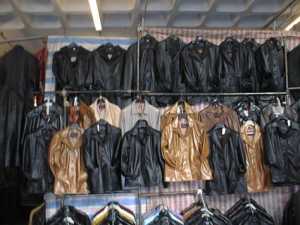 When
Jack decided that it was
time to start his performance,
he would step up and
begin his routine to
attract passers-by to
stop and linger. He would
do this by doing a
warm up. His jocular
manner would soon attract
a crowd around his stall.
Once he had a decent
number of potential punters
standing before them,
he would begin his
warm up in earnest by
telling them some
harmless, if not risqué
stories. I believe that
it was his style more
than the actual stories
themselves that soon got
the crowd laughing and
putting them in a good
mood, which later
guaranteed a willingness
to open wallets and
purses alike. When
Jack decided that it was
time to start his performance,
he would step up and
begin his routine to
attract passers-by to
stop and linger. He would
do this by doing a
warm up. His jocular
manner would soon attract
a crowd around his stall.
Once he had a decent
number of potential punters
standing before them,
he would begin his
warm up in earnest by
telling them some
harmless, if not risqué
stories. I believe that
it was his style more
than the actual stories
themselves that soon got
the crowd laughing and
putting them in a good
mood, which later
guaranteed a willingness
to open wallets and
purses alike.
If Jack
was lucky, there were be
a group of middle-aged
women in the audience.
Such women were like gold
to a vendor since
they were ready,
willing and able to
respond to
just-about-anything that
he said. Their response
was the catalyst he
needed to fire up
the rest of the
on-lookers. Individually,
each of these women was
normal a quiet and
well-mannered mother and matron,
however when in a group
of her peers, she was
anything but! These women
were out together for the
morning and were on a beano!
For a few hours, they
were free of their
husbands and kids and
were looking for harmless
amusement and for simple
fun. Remember, this was
an era where there were
few places for women to
behave as badly as men
– this was a time
before hen parties and
male strippers.
When it came to
Jack’s warm-up stories,
the more vulgar,
the more obvious the innuendo,
the more these ladies
squealed, screamed and
guffawed in mock surprise
before collapsing
into raucous laughter.
Every punch line, every
innuendo also brought
nudges between the group
members, which served to
inform their mates that
they had fully understood
the joke.
After a
suitable period of time,
the hoots, hollers and
squeals of the
amused would have
attracted a goodly number
of people from around the
area to the stall. Most
were attracted by the
laughter and came more to
see what all the noise
was about, than to
buy the products. Jack,
raised up on his throne
with his court before
him, was now ready to
turn to the job in hand
and start his actual pitching.
His selling technique was
done with a certain flare
and always guaranteed a
goodly number of oohs and
ahhs from his
fans.
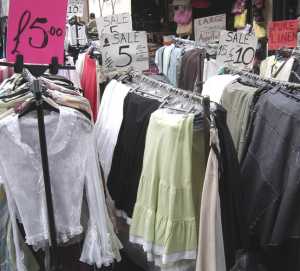 Jack
began his sales pitch
by producing some object,
such as a plate or a
vase. He would hurl it
high into the air and
catch it with his other
hand that he had quickly
moved behind his back
just in time to stop it
clattering to the ground.
He would perhaps repeat
this action a number of
times with minor
variations such as
spinning around prior to
the catch. While he
continued to entertain
the crowd with his
juggling, he would be
extolling the virtues of
the twirling object.
Other vendors were
perhaps more dexterous in
their juggling, but were
less appealing to me. I
remember one vendor in
particular who was able
to hurl what seemed to be
vast numbers of plates
and cups into the air and
successfully bring them
back to safety without
breakage. Dexterous he
might have been, but his patter
lacked that certain
style and rhythm that was
Jack’s trademark. Jack
began his sales pitch
by producing some object,
such as a plate or a
vase. He would hurl it
high into the air and
catch it with his other
hand that he had quickly
moved behind his back
just in time to stop it
clattering to the ground.
He would perhaps repeat
this action a number of
times with minor
variations such as
spinning around prior to
the catch. While he
continued to entertain
the crowd with his
juggling, he would be
extolling the virtues of
the twirling object.
Other vendors were
perhaps more dexterous in
their juggling, but were
less appealing to me. I
remember one vendor in
particular who was able
to hurl what seemed to be
vast numbers of plates
and cups into the air and
successfully bring them
back to safety without
breakage. Dexterous he
might have been, but his patter
lacked that certain
style and rhythm that was
Jack’s trademark.
Jack’s
shenanigans served
to shift the
audience’s interest
momentarily away from him
to the flying object and
to develop further an
atmosphere conducive to
the opening of wallets
and purses. Next he might
slap the object
between twirls while
continuing to extol its
virtues. His words and
maneuvers cunningly
established in the punter’s
mind that here,
before them, was
something of excellent
quality and, more
importantly, caused them
to wonder how it was that
they had managed their
life without before
owning one, or perhaps
two of them. He would pepper
his spiel with
suggestions on how this
magnificent and vital
object would perhaps make
the ideal present for that
most difficult person –
you know, that person
that you never seem able
to please – and
here he would then, in an
off-hand manner mention mother-in-laws!
This could cause many of
the men in the crowd to
start to laugh, but their
responses would soon be
cut short by the sour
looks given to them by
their wives. Not to be
defeated, Jack next told
them that his
mother-in-law now looked
at him with new and
kind eyes since he
bought the old
battleaxe one! This
remark was certain to
establish a sense of
camaraderie amongst most
married men in the crowd
and Jack, which gave them
the necessary courage to
overcome their
wives’ displeasure
and allowed them to roar
aloud with laughter. It
was now their turn to
nudge their mates in the
ribs thereby reasserting
their unison against the
common foe.
 Now
with almost everyone
laughing and having a
good time, it was time
for Jack to get down to
business. Next he would
subtly direct the
crowd’s attention to
the value of the object.
He would begin, and take
great pleasure in doing
so, by informing his
endearing audience how
much this magnificent
and useful present
for someone near and
dear would fetch
up West –
meaning the cost when
bought at the large and
fancy department stores
of Oxford and Regent
Streets or Kensington.
Naturally, the helpers,
now strategically
positioned throughout the
crowd, would lead the
onlookers in gasps and
displays of shock at such
an outrageous price
and everyone would be
shaking their heads in
disbelief. Jack would
then tell his audience
that he would insult
them by asking this
price. No sir! He
would then become serious
and would suggest lesser
prices. Upon the mere
mention of a lesser
price, he would slap the
object of interest and
yelp, with great gusto, NO!
I will not even ask you
for this. No! No! No! Each
additional rejection
would naturally be
punctuated with more
slaps. Now
with almost everyone
laughing and having a
good time, it was time
for Jack to get down to
business. Next he would
subtly direct the
crowd’s attention to
the value of the object.
He would begin, and take
great pleasure in doing
so, by informing his
endearing audience how
much this magnificent
and useful present
for someone near and
dear would fetch
up West –
meaning the cost when
bought at the large and
fancy department stores
of Oxford and Regent
Streets or Kensington.
Naturally, the helpers,
now strategically
positioned throughout the
crowd, would lead the
onlookers in gasps and
displays of shock at such
an outrageous price
and everyone would be
shaking their heads in
disbelief. Jack would
then tell his audience
that he would insult
them by asking this
price. No sir! He
would then become serious
and would suggest lesser
prices. Upon the mere
mention of a lesser
price, he would slap the
object of interest and
yelp, with great gusto, NO!
I will not even ask you
for this. No! No! No! Each
additional rejection
would naturally be
punctuated with more
slaps.
Jack, who
had excellent timing,
would next pause for a
second or two to allow
the audience to grasp the
full nature of his
generosity and also to
allow them to prepare
itself for the great
shock that was about
to come.
During
Jack’s perfectly
timed pause, a ripple of
excitement would pass
throughout the audience
in anticipation of what
they were about to hear.
For they knew that now
they were about to be
treated to an exceptional
price, which they hoped
was going to be within
their budgets. Naturally,
should no ripple develop
the helpers who
were fully versed in the
art of ripple
development, would be
sure to start one! Now
with everyone riveted to
his every word, Jack
would yell what he
considered to be a
ridiculously low price
out loud and then quickly
fall back a little, which
served to feign both
shock and exhaustion and
also in response to his
mock belief that the
crowd would now surge
forward, stampede
fashion, to claim one of
these objects for
themselves. But before
anyone could actually
rush forward and demand
to be sold the precious
commodity, he would raise
his hand. This action
served once more to bring
to silence the now very
interested public,
who naturally were unable
to resist what they took
to be a bargain.
Jack, in true
showman-like fashion next
closed his eyes, and as
if in a trance, and
following yet another
suitable pause, would
slowly open them and slap
the priceless and
now salivated over object
once again. He would say
that since he liked
this morning’s crowd
very much, he was
going to do each and
everyone present a
favour! The crowd was
now panting and
ready once more to
pounce. Again, a raised
hand brought them to a
hush. Now at last, Jack
was ready to stop toying
with the crowds emotions,
which had been ebbing and
flowing these last few
minutes, and go for the jugular!
Like the matador standing
before a bruised and
battered bull, he was
ready to take his final plunge
at them. Now,
quietly, rather than in a
flurry, above the
tranquility that had
settled over his
audience, he almost
whispered, in humble
tone of course, that
in order to clear his
stall of the offending
object, he was prepared
to take a loss and
was willing to offer it
to the public for –
and here he raised his
voice to a crescendo
– and told them his
final offer!
 This
final price was always
greeted with gasps of
disbelief! However, the
feeling of disbelief was
not allowed to last, and
so interfere with
business, as the helpers
sprang into life and
began darting back
and forth in an all-out
effort to rid the stall
of the suddenly
offending object by
placing it in the
grasping hands of the
customers. While the
buying frenzy continued,
Jack would continue his patter
along with constant
reminders that he was making
nothing from these
sales and that if he
continued to be so
generous to such a
lovely crowd today, he
would find himself in the
poor house. This
final price was always
greeted with gasps of
disbelief! However, the
feeling of disbelief was
not allowed to last, and
so interfere with
business, as the helpers
sprang into life and
began darting back
and forth in an all-out
effort to rid the stall
of the suddenly
offending object by
placing it in the
grasping hands of the
customers. While the
buying frenzy continued,
Jack would continue his patter
along with constant
reminders that he was making
nothing from these
sales and that if he
continued to be so
generous to such a
lovely crowd today, he
would find himself in the
poor house.
The prices
that were asked by a
seller were generally the
cost of a note – either
a pound or
multiples of them or
perhaps a ten shilling
note – certainly
nothing that would
require the giving of
change as this would
impede business. The helpers
were quick on their
feet and continued to
dart about the crowd with
the agility of young
gazelles so as to leave
no punter
disappointed. Bank notes
were stuffed into the
zipped money belt around
their waists, which soon
took on a bulged
appearance.
Within
minutes, the stall was
cleared of the offending
objects. Once the
public had their own
package, their tongues
would be loosened and
they would be telling
each other how fortunate
they were to obtain such
a wonderful bargain.
However, nothing is
for nothing, especially
when it is obtained in a
street market! For now,
the real selling
was about to begin.
Although
some of the public –
the shrewd ones –
would take off for sellers
new, others would
remain. These were the
people who were
mesmerized by the scene
set by Jack and were
eager for more free
entertainment and even
more eager to obtain more
bargains. They
would soon be joined by
others who had heard of
the giveaways Jack’s
stall. Now that Jack had
an audience begging to
buy, he moved into his real
sale pitch mode.
Jack, with great
dexterity along with a
tremendous amount of
charm and guile, would
offer vases, dinner and
tea services etc
and offer them at less
than rock bottom
prices. Many punters
were now programmed into
thinking that everything
offered was really at a bargain
price and would
eagerly button hole a
helper in order to
be sure they were not
forgotten when the
selling began.
 Jack
and his cohorts down
the lane were true
masters of entertainment
and could keep the public
in stitches with
their jokes and comments.
Sellers were cunning
fellows and would
invariably turn their
charm onto one
particular woman in the
audience. They would
generally choose a woman
of middle aged years who
would invariably be
slightly overweight,
perhaps a bit dowdy and
possibly feeling slightly
neglected by her husband
and family despite her
efforts to make a happy
and comfortable home for
them. They would find something
– anything – to
complement her on –
perhaps her hair, her
coat etc –
and start to engage her
in conversation. Often
they might ask her for
her opinion of an object
and then complement her
on her good taste. The
woman, being unused to
complements and perhaps
starved for attention,
would be flattered and
might giggle and smile in
appreciation. During the
course of his spiel,
the seller would
return to her
periodically being sure
to use her name, which he
had been sure to obtain
during their initial
interaction. This mild
flirting would cause the
ladies of the audience of
similar age and
disposition to eat out
of the seller’s
hands once more while
passing notes and
coins to the helpers in
return for objects that
would soon be placed in
those out-of-reach
kitchen cabinets
following little use.
Still, most ladies would
not regret their
purchases since for a few
moments they were seen as
women and were not just
as someone’s wife or
somebody else’s
mother. Jack
and his cohorts down
the lane were true
masters of entertainment
and could keep the public
in stitches with
their jokes and comments.
Sellers were cunning
fellows and would
invariably turn their
charm onto one
particular woman in the
audience. They would
generally choose a woman
of middle aged years who
would invariably be
slightly overweight,
perhaps a bit dowdy and
possibly feeling slightly
neglected by her husband
and family despite her
efforts to make a happy
and comfortable home for
them. They would find something
– anything – to
complement her on –
perhaps her hair, her
coat etc –
and start to engage her
in conversation. Often
they might ask her for
her opinion of an object
and then complement her
on her good taste. The
woman, being unused to
complements and perhaps
starved for attention,
would be flattered and
might giggle and smile in
appreciation. During the
course of his spiel,
the seller would
return to her
periodically being sure
to use her name, which he
had been sure to obtain
during their initial
interaction. This mild
flirting would cause the
ladies of the audience of
similar age and
disposition to eat out
of the seller’s
hands once more while
passing notes and
coins to the helpers in
return for objects that
would soon be placed in
those out-of-reach
kitchen cabinets
following little use.
Still, most ladies would
not regret their
purchases since for a few
moments they were seen as
women and were not just
as someone’s wife or
somebody else’s
mother.
A performance
lasted for as long as
the seller felt
that sales were going
well. Most sellers in
those days were not
greedy fellows. They
realized that others
further down the lane also
needed to get a taste
of the pigeons and so
would not allow them to overstay
his welcome. Like
every good entertainer of
the day, the seller knew
how to end his act and
always had a good finale
that always left the punters
wanting more. Jack et
al were always sure
to wish those special
women that had been
singled out for particular
attention well and
requested that they and
everyone else come back
next week to see him when
he would be sure to have
more bargains just for
them.
I always
found Jack’s performance
to be great stuff and
the entertainment given
easily rivaled what was
heard on the radio and
seen at the pictures.
Since I was very taken
with the costermonger
life when I was a
kid, I decided that this
was going to be the
life for me after I
grew up! When I shared
this declaration with my
parents, I remember that
my mother was none too
pleased. Apparently not
every woman of a
certain age fell
victim to Jack’s
charms or saw the joys of
barking on a stall
down the lane!
As a
child, whenever I went down
the lane, the buying
of cups and saucers and
the like were of little
interest to me. However,
my father had a certain
interest in stalls
selling crockery. For he
had a quest! To
me, at that time, I felt
that his life was dedicated
to the search, and
finding, of his version
of the Holy Grail!
Please do not think for a
moment that I jest here!
For I do not! Also,
please do not think that
I am being blasphemous
either, as I do not
intend to be. My father
could not pass a shop, a
stall, a department store
without stopping to look
and rummage through the
wares, for he was always
on the lookout for
the perfect cup.
But this is another
story.
 Not
everyone that worked
the lane was as
honest and good-natured
as Jack. Like any place
where crowds are formed,
there was a fair share of
dishonest and slightly
dishonest people.
Naturally, the market was
littered with pickpockets.
Sensible woman carried
their handbags on their
shoulders. Men kept their
wallets in inside
pockets, out of the way
of sticky fingers.
Still, there were many,
who without thinking,
would expose their hard
earned cash to the
elements, and quick as
a flash, whoosh, it
would be gone! Not
everyone that worked
the lane was as
honest and good-natured
as Jack. Like any place
where crowds are formed,
there was a fair share of
dishonest and slightly
dishonest people.
Naturally, the market was
littered with pickpockets.
Sensible woman carried
their handbags on their
shoulders. Men kept their
wallets in inside
pockets, out of the way
of sticky fingers.
Still, there were many,
who without thinking,
would expose their hard
earned cash to the
elements, and quick as
a flash, whoosh, it
would be gone!
The
tradesmen or costermongers
required a license to
sell goods from a stall.
This license is supposed
to be displayed in full
view of the public so
that the punters know
that they are buying with
a legitimate person.
Naturally, where there
are laws and rules, there
are going to those that
will want to break them.
And a market is full of
those folks who are
unwilling or un-wanting
to follow the laws and
want to sell goods
without forking out money
to buy a license. These fellas,
although often hard
working, belonged to the get-rich-quick
group.
Some were halfway
decent and had good
natures and good hearts
and did not break any serious
laws. They were
generally looked upon
reasonably kindly by the beak
– judge or
magistrate – once
they found themselves
arrested by a copper and
brought to court. Since
they were generally
caught red-handed breaking
the law, and since they
were realistic about
the pros and cons
of their chosen lifestyle
and knew that they had
to take their medicine, they
would plead
guil’y yer
‘onour (i.e.
guilty your Honour), pay
their fine and be out to
renew their business
acquaintances within the
hour. Naturally, beaks
did not look kindly
upon habitual offenders.
These
kinds of petty crooks were
basically harmless
fellows and had a
willingness to work hard.
Most scratched out a
living and rarely made
the fortune that they
dreamed of. Like most
people of the time, they
enjoyed betting on dog
and horse races and would
often blow any
profit, no matter how
large or small, on a cert
or a sure thing
running in the 3
o’clock at Kempton. This
tip, which was guaranteed
to romp home ten
lengths ahead of the
field and at 100-1, was
either given to them by
a mate who heard about it
from another mate who
knew about it from the
jockey or was bought
for a pittance, most
likely in a pub, from a
stranger, but who seemed
to know what he was
about! Like most tips,
their horses either came
in last or fell at the
first jump and they were
left with nothing.
These more
pleasant get-rich-quick
boys were generally
called wide
boys
while the more dishonest
one, who broke more
serious laws, were
generally known as spivs.
The two groups of crooks
shared two things in
common: firstly, they
generally were local
boys and secondly,
they dressed in a
particular style that did
not allow the average
person to distinguish
between them.
 Spivs
and wide boys
dressed in what could
only be described as a flash
manner. The
term wide boy
referred to the width of
the ties that they wore,
hence the name. These
ties were brightly
coloured and were painted
with exaggerated
motifs such as hula
girls and naked
girls in seductive poses.
Already, their ties set
them apart from the
remainder of society.
Besides the wearing of
outrageous colourful wide
ties, they also wore
large trilby hats
with the brims turned
down at the front and
worn at a jaunty
angle. Their suits
were double-breasted and
with much padding at the
shoulders. The suit
material was generally of
cheap fabric and dyed
with
less-than-conservative
colours. Unfortunately,
exaggerated strips were
also very popular. Their
shoe wear was special and
unique to them. They
liked what were called crepe
shoes. These were
what looked like lace-up
black or brown
conventional shoes, but
differed from the norm as
they had very high soles
made from crepe, which
was a synthetic rubber. Wide
boys could be
legitimate vendors or
else small time crooks,
whereas a spiv was
always thought of as
someone dodgy and
never to be trusted. Spivs
and wide boys
dressed in what could
only be described as a flash
manner. The
term wide boy
referred to the width of
the ties that they wore,
hence the name. These
ties were brightly
coloured and were painted
with exaggerated
motifs such as hula
girls and naked
girls in seductive poses.
Already, their ties set
them apart from the
remainder of society.
Besides the wearing of
outrageous colourful wide
ties, they also wore
large trilby hats
with the brims turned
down at the front and
worn at a jaunty
angle. Their suits
were double-breasted and
with much padding at the
shoulders. The suit
material was generally of
cheap fabric and dyed
with
less-than-conservative
colours. Unfortunately,
exaggerated strips were
also very popular. Their
shoe wear was special and
unique to them. They
liked what were called crepe
shoes. These were
what looked like lace-up
black or brown
conventional shoes, but
differed from the norm as
they had very high soles
made from crepe, which
was a synthetic rubber. Wide
boys could be
legitimate vendors or
else small time crooks,
whereas a spiv was
always thought of as
someone dodgy and
never to be trusted.
Wide
boys could be divided
into two groups: those
that worked out of an
attaché case or
those that worked from
a barrow. The ones
that worked from an
attaché case were more
mobile and were often
able to out run the
police once spotted. They
would rest their case
either on the ground or
on a portable stand,
which they carried. These
fellas were not
official vendors and so
had no official pitch in
a market. Instead, they
would set-up wherever
they felt that there was
a clientele available to
them. Generally, this was
in a market or else in a
shopping street. When I
was a kid, Oxford
Street was filled
with wide boys standing
in the gutter with their
cases open on the
pavement. There would
always be a small group
of people around them,
who would be rummaging
around in the case or
else looking at specimens
handed to them. People
did not seem to care that
these men had no license
to sell goods. All they
cared about was that they
had bargains for sale.
Generally they sold
things that would appeal
to women, but not always.
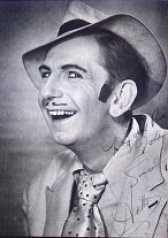 |
|
 |
| Arthur
English as a wide boy |
|
Arthur
English as Mr. Harman
in Are You Being
Served? |
In
the days after the war,
women’s stockings
were expensive and not
always easy to get. It
was not uncommon for boxes
of stockings to fall
off the back of a lorry.
These wares would soon
find their way into the
attaché case of a wide
boy and be on offer
at a good price. Seemingly,
everyone was happy once a
sale took place –
everyone that is except
the original owner. If a wide
boy could carry it
and it fitted into an
attaché case, he would
be willing to flog it.
And invariably, he
would find a market.
Wrist
watches were also a very
common piece of
merchandise that was a good
earner for a wide
boy. Such commodities
were a perfect thing to
tote. They were popular
with the punters and
extremely easy to
transport since they
could be carried on
the arms. All a wide
boy had to do to display
his wares was to
raise his sleeves! People
lapped up this
sort of thing! And the wide
boys didn’t have
to worry so much about the
bill.
The other
type of wide boy worked
from a barrow or
push stall. These fellows
were often called barrow
(bar-ra) boys and had
the reputation of being
slightly less savory than
those that touted
attaché cases. A bar-ra
boy generally sold
fruit and vegetables.
Although most were fair
and gave value for
money, some did not.
They were famous for
putting the best fruit at
the front of the display
so as to entice customers
and then selling less
than perfect examples
from the back. The more honest
ones did not try to pass
off rotten fruit on
an unsuspecting customer,
but other did. One also
needed to be concerned
about their scales, since
they were not subject to
check from the people
that concerned themselves
with correct weights
and measures. It
could often be a case of buyer
beware when dealing
with a bar-ra boy. But
careful inspection of the
fella, as well as
some inspection of what
others had bought would
soon let the clever
customer know he was
reputable or not.
For those
dissatisfied punters who
brought back
less-than-ideal fruit
along with a demand for
the return of their money
or else a wish to choose
from the front display.
These kind of bar-ra
boys were generally
not folks to mess with
since they did not
take criticism well.
Sadly, such interaction
would lead to words
being said, which
occasionally led to fists
flying and would end
with the punter getting
a punch up the throat!
Bar-ra
boys did not have a
legal pitch, but rather
moved along a street as
needed. The tradesmen would
generally push his stall
along. Occasionally, he
would have this done by a
horse, but in general,
the use of a horse was
left to the legitimate barrow
boys who had
licenses.
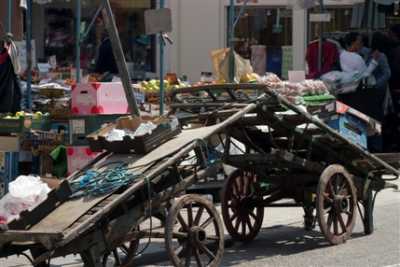 |
|
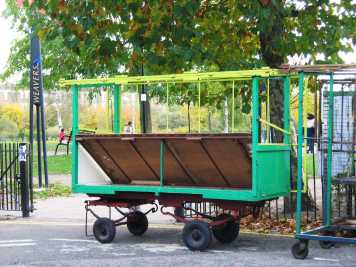 |
| Old
barrows |
|
Modern
stall |
 The
Bill, as the police
have been affectionally
called for years, was
quick off the mark when
it came to wide boys. Obviously
their fines brought in a
decent amount of revenue
for the Borough. Once the
cops spotted one,
they would swoop and
a collar was
quickly made. In those
days, the plod did
not generally ride around
in cars. They walked a
beat, which meant
that they walked a
particular route several
times during their shift.
Oftentimes, in an
attempt, to stamp this
kind of thing out, as
magistrates were often
fond of saying, a number
of our boys in blue
would be drafted to a
particular area and they
would attempt to collar
the teams of wide
boys working the
patch that day. The wide
boys, for their part,
were generally organized
when they were not
working alone. They had lookouts
posted about the area
whose job it was to spot
the copper and give
the nod when one or
more was seen. The nod
was generally a loud
whistle – which was
a loud piercing shrill
made by blowing through
the fingers (this was a
skill greatly admired by
children of my day, which
most certainly included
me) or else a shout. Some
days, the wide boys got
caught and were carried
off to the cop shop. Other
times, they took off
double quick and
disappeared, later to
return once old bill had
moved on. The
Bill, as the police
have been affectionally
called for years, was
quick off the mark when
it came to wide boys. Obviously
their fines brought in a
decent amount of revenue
for the Borough. Once the
cops spotted one,
they would swoop and
a collar was
quickly made. In those
days, the plod did
not generally ride around
in cars. They walked a
beat, which meant
that they walked a
particular route several
times during their shift.
Oftentimes, in an
attempt, to stamp this
kind of thing out, as
magistrates were often
fond of saying, a number
of our boys in blue
would be drafted to a
particular area and they
would attempt to collar
the teams of wide
boys working the
patch that day. The wide
boys, for their part,
were generally organized
when they were not
working alone. They had lookouts
posted about the area
whose job it was to spot
the copper and give
the nod when one or
more was seen. The nod
was generally a loud
whistle – which was
a loud piercing shrill
made by blowing through
the fingers (this was a
skill greatly admired by
children of my day, which
most certainly included
me) or else a shout. Some
days, the wide boys got
caught and were carried
off to the cop shop. Other
times, they took off
double quick and
disappeared, later to
return once old bill had
moved on.
It still
amazes me today when I
think about these wide
boys and also of
their modern counterparts
seen in all big cities
and towns today. Their profit
margin must have been
small. However, I expect
that they did manage to eke
out a living mainly
by increasing the volume
sold. It must have been
extremely hard work
requiring many hours of
labour in all kinds of
weather. I used to
wonder, even then, why
they did not make the
effort and just go
legit!
The other
type of crook was more
notorious and dangerous.
This included the
spiv. Although many
were also petty
criminals and perhaps
harmless and well
meaning, others were not.
These were decidedly the
fellows that one needed
to stay away from. These
were crooks and had
either been or were
destined to go to prison.
They were the robbers,
the pickpockets and the
ones had up for GBH
– grievous bodily
harm.
England
has always, despite
popular myth and idea,
been a violent country.
Young men are subject to
fashion and enjoy
following a leader. Many
fashions have been
associated with some form
of violence. Young men
enjoy bashing others
and don’t seem to
mind getting bashed in
return. How else can one
explain the current and
long-term violence at
football matches?

Football
Hooligans
Prior to
this current and
long-term site of
violence, violence was
closely allied with many
fashion trends. For
example, the Mods and
Rockers of the 1960s
– here mods were
those who followed the
current trends while rockers
wore leather and rode
motor bikes. When groups
were encouraged to meet
– such as on a Bank
Holiday in a seaside
resort – violence
would be sure to erupt
and people would get
hurt. Prior to this came teddy
boys who dressed in
an Edwardian style and
were often violent in
mood. Many carried
bicycle chains for
defence. When I was
young, London was plagued
by a group of young
hooligans known as cosh
boys.
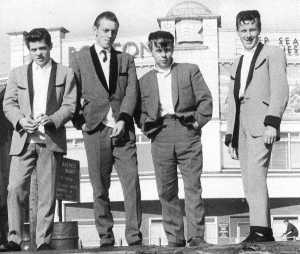 |
|
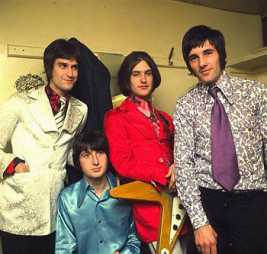 |
|
 |
| Teddy Boys |
|
Mods - The
Kinks |
|
Rockers |
Cosh
boys were youths and
young men that carried an
implement called a
cosh. This was
generally a long –
about six to eight inches
in length – leather
sac filled with something
like sand and used to
bring down on the head of
anyone that got in the
way of the owner. For
a time, after the war,
various part of England
suffered an increase in
assaults. According to
the Metropolitan
Police, a new kind of
criminal appeared after
the war, one that was not
afraid to combine
violence with crime.
Other such criminals also
carried cut-throat
razors, which they
were happy to wield
against anyone who
opposed them. The East
End of London spawned
many such cosh and
razor boys.
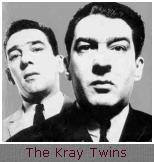 Although
not all spivs carried
coshes or razors,
many did. Spivs tended
to be much more organized
in breaking of the law.
They often were the
culprits of bank hold-ups
and other robberies and
most often associated
themselves in gangs. When
they came up before
the beak, it was
generally for crimes that
brought them serious
time. Unlike the wide
boys, they did not
get off with a fine and a
slap on the wrist. The
most notorious of such
people were the infamous
Kray Twins, who
frequented the Blind
Beggar public house,
not a stone’s throw
from my parent’s pie
‘n’ mash shop and
who spent the remainder
of their lives enjoying Her
Majesty’s Pleasure. Although
not all spivs carried
coshes or razors,
many did. Spivs tended
to be much more organized
in breaking of the law.
They often were the
culprits of bank hold-ups
and other robberies and
most often associated
themselves in gangs. When
they came up before
the beak, it was
generally for crimes that
brought them serious
time. Unlike the wide
boys, they did not
get off with a fine and a
slap on the wrist. The
most notorious of such
people were the infamous
Kray Twins, who
frequented the Blind
Beggar public house,
not a stone’s throw
from my parent’s pie
‘n’ mash shop and
who spent the remainder
of their lives enjoying Her
Majesty’s Pleasure.
Petticoat
Lane is still open
for business every Sunday
– rain or shine
– and has perhaps
changed little over the
years. The faces of the sellers
may change and
everything may seem to
cost that much more
today, but the basic
premise is still in
existence. People flock down
the lane for bargains
and to be entertained.
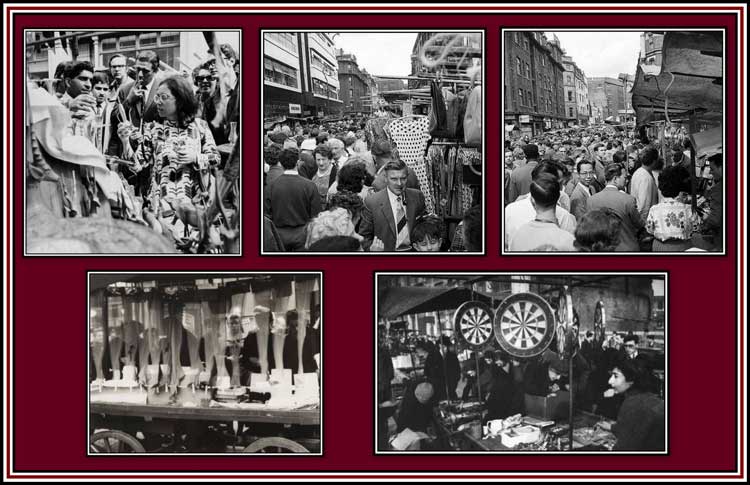
|